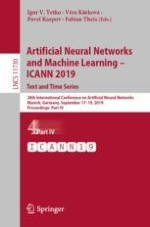2019 | Book
Artificial Neural Networks and Machine Learning – ICANN 2019: Text and Time Series
28th International Conference on Artificial Neural Networks, Munich, Germany, September 17–19, 2019, Proceedings, Part IV
Editors: Igor V. Tetko, Dr. Věra Kůrková, Pavel Karpov, Prof. Fabian Theis
Publisher: Springer International Publishing
Book Series : Lecture Notes in Computer Science
